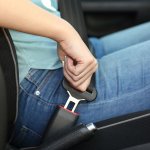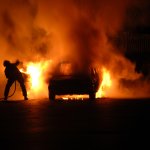Avoiding Accidents and Injury When Your Car Breaks Down #MoveOver
At Joseph Joy and Associates, we have represented many clients who have sustained injury in car accidents in Lafayette and Acadiana due to the negligence of someone else. Many of these personal injury cases could have been prevented with a greater degree of care by the defendant driver. One example of a dangerous situation that leads to a preventable accident involves broken-down vehicles: flat tires, stalling out, etc. As drivers, we should familiarize ourselves with the proper procedure should your vehicle break down on the road.
It’s a horrible feeling when you are driving and your engine starts sputtering. Or your car runs out of gas. Suddenly, your vehicle is slowing down and if you are on a major highway or the I-10, you and your passengers could be in danger. What to do?
It is one of the rare occurrences when you can turn on your hazard lights in Louisiana.
TITLE 32 — Motor vehicles and traffic regulation. RS 32:327 — Special restrictions on lamps
- Flashing lights are prohibited except on authorized emergency vehicles, school buses, or on any vehicle as a means of indicating a right or left turn, or the presence of a vehicular traffic hazard requiring unusual care in approaching, overtaking or passing.*
The Louisiana Department of Transportation and Development’s Motorist Assistance Patrol assists motorists and improves traffic flow through its contracted MAP service. Providing free services to stranded motorists in Baton Rouge, New Orleans, Lake Charles, and Shreveport-Bossier City, MAP both reduces traffic congestion caused by stalled vehicles and provides safety and comfort to those stranded. With an average of 600 motorists assisted each week, DOTD has helped thousands of Louisiana interstate travelers over the past few years. If you become stranded and need assistance from the Motorist Assistance Patrol, contact your local law enforcement. In an emergency situation, dial 911.
And of course, #MOVEOVER. Pull off the road as soon and safely as you can. The American Automobile Association, aaa.com, has some helpful advice about what to do in these dangerous situations. According to AAA, on most roads, you should exit onto the far right shoulder, as far off the road as possible while remaining on level ground. If you are driving on an interstate or multiple-lane highway with medians, you may consider the left shoulder, again pulling as far away from traffic as possible. Here’s more tips from AAA, but of course every situation is different. First and foremost, use common sense and act responsibly.
If you get out of your vehicle, proceed carefully and watch for oncoming traffic, especially at night or in bad weather, when visibility is limited.
Never stand behind or directly in front of your vehicle. Other roadway users may have trouble seeing you, and you could be struck by another vehicle.
What if you CANNOT pull off the road? Do not risk personal injury by attempting to push it to a safe location. If you cannot get your vehicle to a location away from traffic, or if you are uncertain about your safety and think your vehicle may get struck from behind, do not stay in your vehicle.
- Alert other motorists. Make sure your vehicle is visible to other motorists.
- Remember they may be traveling at a high rate of speed and must be able to see your vehicle from a great distance to stop or move to another lane.
- Turn on the emergency flashers, especially at night or during inclement weather.
- Raise your vehicle’s hood. If you have a brightly colored handkerchief or scarf, tie it to the antenna or door handle, or hold it in place by closing it in a window.
- Place flares or warning triangles to direct oncoming traffic away from your vehicle.
If you are experiencing a fuel leak or smell fuel fumes, do not ignite flares or use anything with a flame. Extinguish any lit cigarettes.
Communicate your situation. Once you and any passengers are in a safe location, you can notify others of your vehicle break- down. Make note of surroundings and landmarks, buildings or road signs.
If you have a cell phone, immediately use it to call for help. Make the call from inside your vehicle if you are safely out of traffic. Otherwise, do so at a safe distance from the vehicle and roadway.
Remain with your vehicle. Safety experts agree that under most circumstances if you are able to pull away from traffic, it is safest to remain in your vehicle until a law enforcement officer or road service provider arrives.
Always be mindful of your surroundings. At night, carry a flashlight.
If you choose to exit the vehicle, do so safely and well away from oncoming traffic and your vehicle. If possible, you and any passengers should exit through the side of the vehicle facing away from the road. In most cases, the passenger side of the vehicle allows for greater distance from oncoming traffic.
If you determine help is within walking distance, think about whether it’s safe to leave your vehicle or passengers for a short period of time. Assess traffic conditions and ensure that your contemplated route is safe for pedestrians. If you leave your vehicle, place a note on the dashboard listing where you are going for help and the time you left.
If you choose to stay inside your vehicle, keep the windows almost closed and the doors locked. It’s very dangerous to lower your windows or open your vehicle doors to strangers. If a stranger does stop to offer help, ask the person to call for emergency road service.
If you are threatened or harassed while waiting in your car, honk the horn repeatedly and flash the lights to attract attention.
Loss of life and personal injury is the ultimate price to pay for vehicular accidents. At Joseph Joy and Associates, our personal injury attorneys have recovered millions for clients and their families who have suffered damages due to someone else’s negligence. If you have the unfortunate experience of being seriously injured in an accident involving a car, truck or big rig, give us a call: 337-232-8123 or visit us at 900 S. College Rd., Ste. 204, Lafayette, LA.




